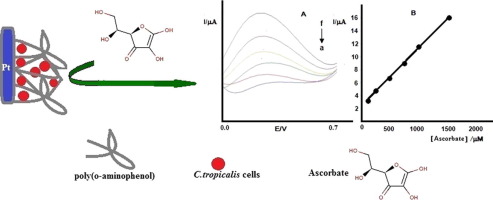当前位置:
X-MOL 学术
›
Bioelectrochemistry
›
论文详情
Our official English website, www.x-mol.net, welcomes your
feedback! (Note: you will need to create a separate account there.)
A novel mıcrobıal bıosensor system based on C. tropicalis yeast cells for selectıve determınatıon of L-Ascorbıc acid.
Bioelectrochemistry ( IF 4.8 ) Pub Date : 2019-12-12 , DOI: 10.1016/j.bioelechem.2019.107420 Erol Akyilmaz 1 , Cansu Guvenc 1 , Hatice Koylu 1
Bioelectrochemistry ( IF 4.8 ) Pub Date : 2019-12-12 , DOI: 10.1016/j.bioelechem.2019.107420 Erol Akyilmaz 1 , Cansu Guvenc 1 , Hatice Koylu 1
Affiliation

|
In this study, a novel microbial biosensor was developed for the selective determination of L-Ascorbic acid. In the construction of the microbial biosensor, lyophilized Candida tropicalis yeast cells were immobilized with o-aminophenol by forming a film layer on a platinum electrode surface using electropolymerization. L-Ascorbic acid was quantified on the basis of both amperometric and differential pulse voltammetry (DPV) methods using the biosensor. The measurements were made at +0.24 V (vs Ag/AgCl) for amperometric studies and between 0.0 V and +0.7 V for DPV studies based on the oxidation of L-Ascorbic acid to dehydro-L-Ascorbic acid by ascorbate oxidase which takes place within the catabolic metabolic pathway of C. tropicalis yeast cells. According to the results obtained from the two methods, the response of the biosensor depends linearly on L-Ascorbic acid concentration between 100 and 1500 μM. The detection limit was 62 μM and 59 μM for amperometric and DPV measurements, respectively. The response time of the microbial biosensor was 14 s and 5 s for DPV and amperometric measurements, respectively. In the optimization studies of the biosensor, some parameters such as the optimum amount of the microorganism, o-aminophenol concentration, pH and temperature were determined. For the characterization of the biosensor, reproducibility, storage stability and the effect of interferences were determined.
中文翻译:

一种基于热带假丝酵母酵母细胞的新型微生物传感器系统,用于确定L-抗坏血酸。
在这项研究中,开发了一种新型的微生物生物传感器,用于选择性测定L-抗坏血酸。在微生物生物传感器的构造中,通过使用电聚合在铂电极表面上形成膜层,将冻干的热带假丝酵母酵母细胞固定在邻氨基苯酚上。使用生物传感器,根据安培法和差分脉冲伏安法(DPV)定量定量L-抗坏血酸。基于抗坏血酸氧化酶将L-抗坏血酸氧化为脱水L-抗坏血酸,在安培法研究中,测量值在+0.24 V(vs Ag / AgCl)下进行,在DPV研究中,测量值在0.0 V至+0.7 V之间进行在热带假丝酵母酵母细胞的分解代谢代谢途径中。根据两种方法得出的结果,生物传感器的响应线性依赖于100至1500μM之间的L-抗坏血酸浓度。安培和DPV测量的检出限分别为62μM和59μM。对于DPV和安培法测量,微生物传感器的响应时间分别为14 s和5 s。在生物传感器的优化研究中,确定了一些参数,例如微生物的最佳量,邻氨基苯酚浓度,pH和温度。为了表征生物传感器,确定了再现性,存储稳定性和干扰的影响。对于DPV和安培法测量,微生物传感器的响应时间分别为14 s和5 s。在生物传感器的优化研究中,确定了一些参数,例如微生物的最佳量,邻氨基苯酚浓度,pH和温度。为了表征生物传感器,确定了再现性,存储稳定性和干扰的影响。对于DPV和安培法测量,微生物传感器的响应时间分别为14 s和5 s。在生物传感器的优化研究中,确定了一些参数,例如微生物的最佳量,邻氨基苯酚浓度,pH和温度。为了表征生物传感器,确定了再现性,存储稳定性和干扰的影响。
更新日期:2019-12-13
中文翻译:

一种基于热带假丝酵母酵母细胞的新型微生物传感器系统,用于确定L-抗坏血酸。
在这项研究中,开发了一种新型的微生物生物传感器,用于选择性测定L-抗坏血酸。在微生物生物传感器的构造中,通过使用电聚合在铂电极表面上形成膜层,将冻干的热带假丝酵母酵母细胞固定在邻氨基苯酚上。使用生物传感器,根据安培法和差分脉冲伏安法(DPV)定量定量L-抗坏血酸。基于抗坏血酸氧化酶将L-抗坏血酸氧化为脱水L-抗坏血酸,在安培法研究中,测量值在+0.24 V(vs Ag / AgCl)下进行,在DPV研究中,测量值在0.0 V至+0.7 V之间进行在热带假丝酵母酵母细胞的分解代谢代谢途径中。根据两种方法得出的结果,生物传感器的响应线性依赖于100至1500μM之间的L-抗坏血酸浓度。安培和DPV测量的检出限分别为62μM和59μM。对于DPV和安培法测量,微生物传感器的响应时间分别为14 s和5 s。在生物传感器的优化研究中,确定了一些参数,例如微生物的最佳量,邻氨基苯酚浓度,pH和温度。为了表征生物传感器,确定了再现性,存储稳定性和干扰的影响。对于DPV和安培法测量,微生物传感器的响应时间分别为14 s和5 s。在生物传感器的优化研究中,确定了一些参数,例如微生物的最佳量,邻氨基苯酚浓度,pH和温度。为了表征生物传感器,确定了再现性,存储稳定性和干扰的影响。对于DPV和安培法测量,微生物传感器的响应时间分别为14 s和5 s。在生物传感器的优化研究中,确定了一些参数,例如微生物的最佳量,邻氨基苯酚浓度,pH和温度。为了表征生物传感器,确定了再现性,存储稳定性和干扰的影响。









































 京公网安备 11010802027423号
京公网安备 11010802027423号